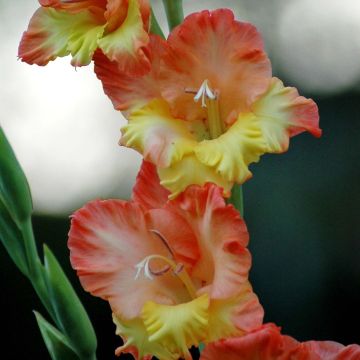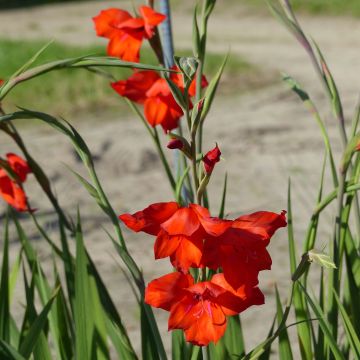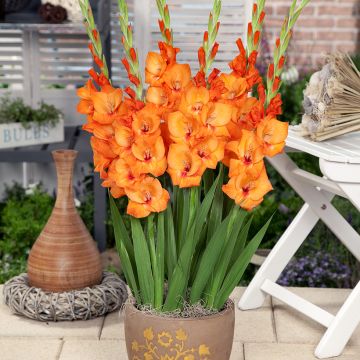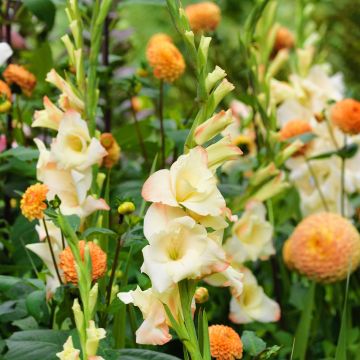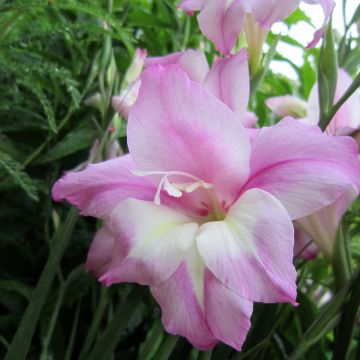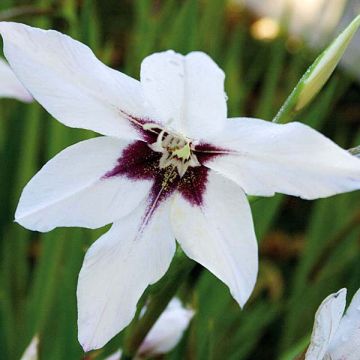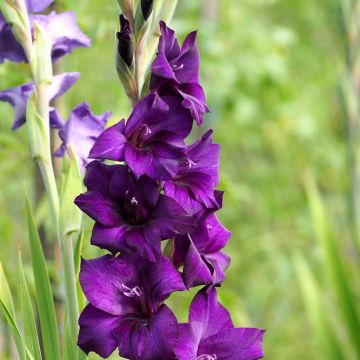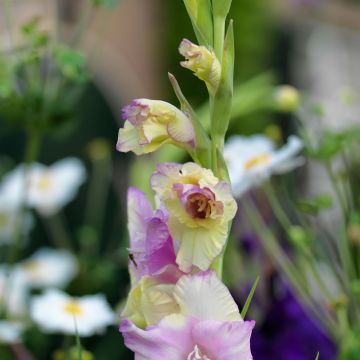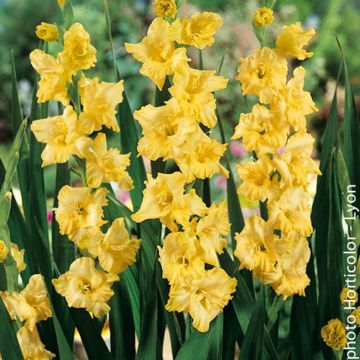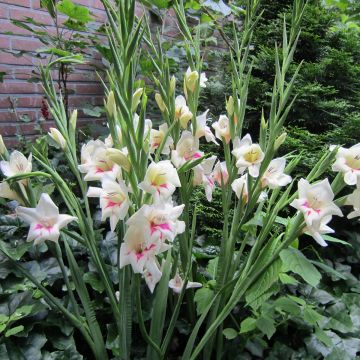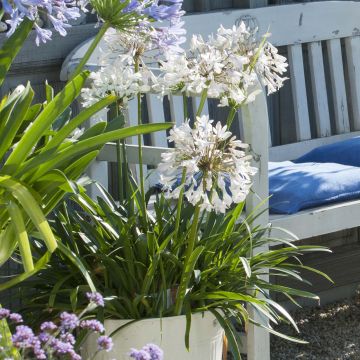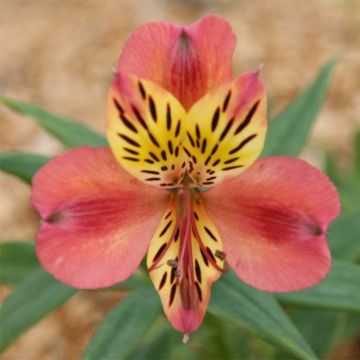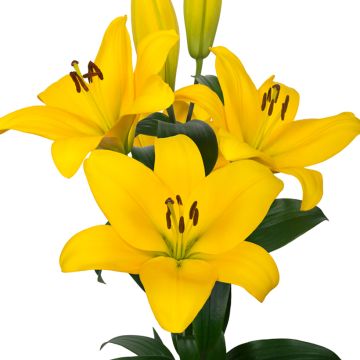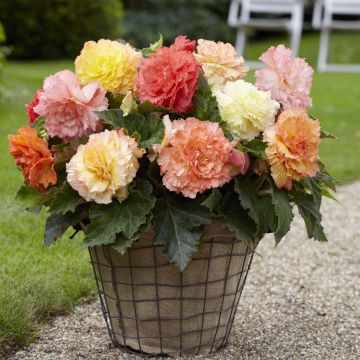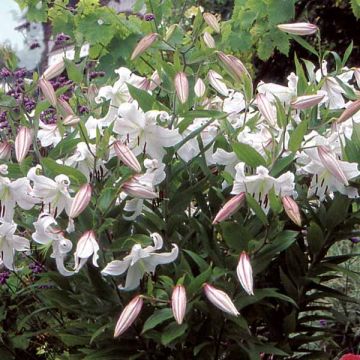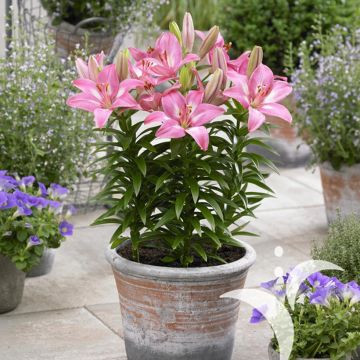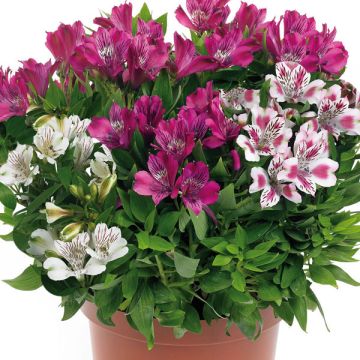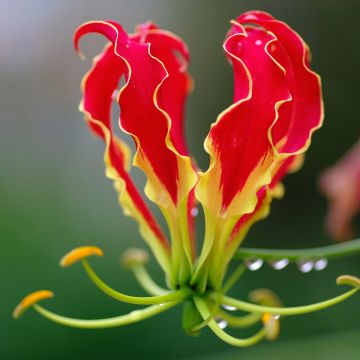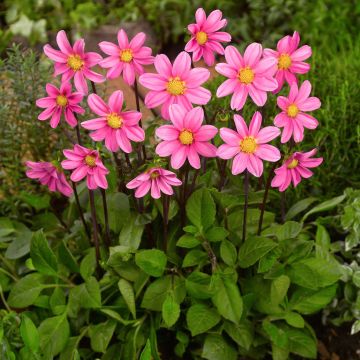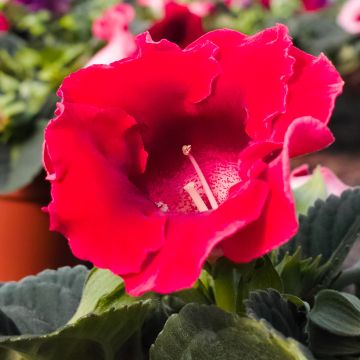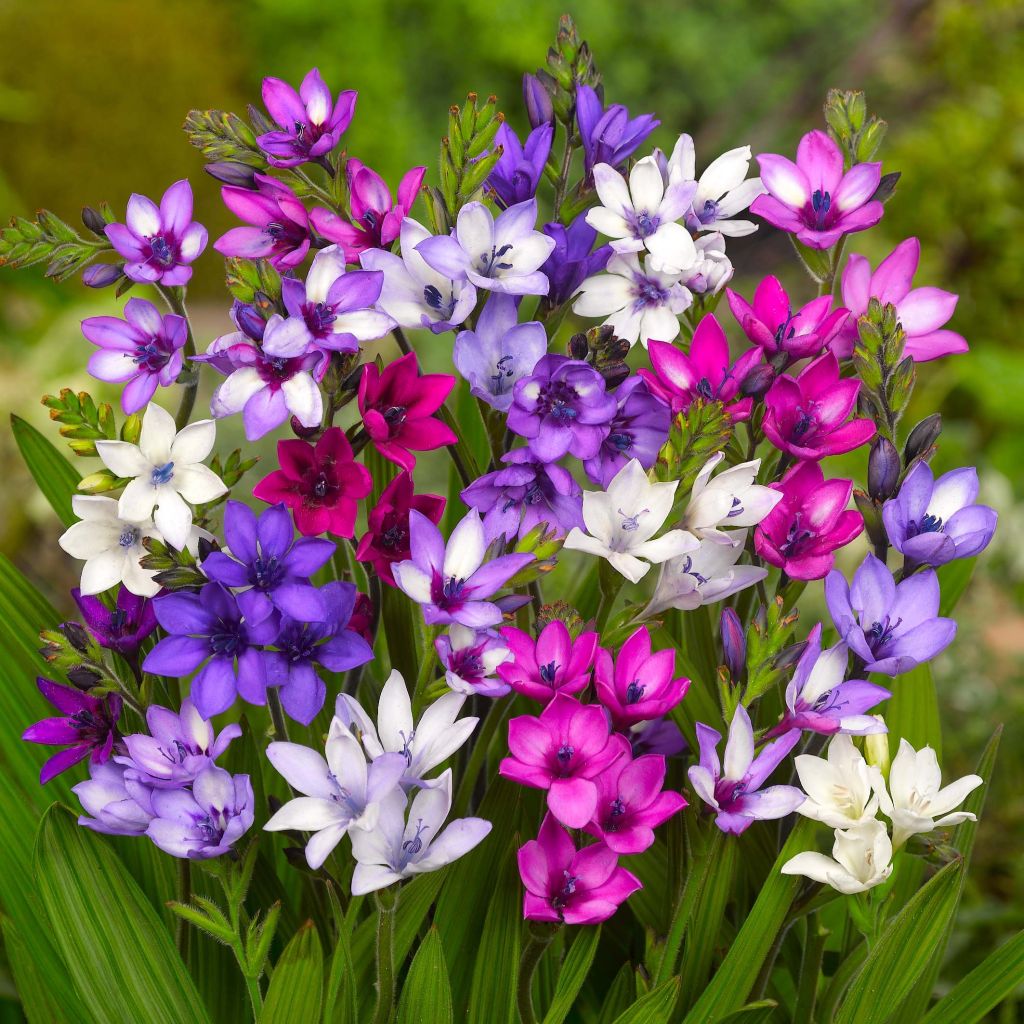

Babiana stricta - Blue Baboon Flower
Babiana stricta - Blue Baboon Flower
Babiana stricta
Baboon Flower, Blue Freesia
No text to translate.
Michèle, 06/10/2024
This item cannot be shipped to the selected country
Delivery charge from €5.90
More information
Schedule delivery date,
and select date in basket
This plant carries a 6 months recovery warranty
More information
We guarantee the quality of our plants for a full growing cycle, and will replace at our expense any plant that fails to recover under normal climatic and planting conditions.
From €5.90 for pickup delivery and €6.90 for home delivery
Express home delivery from €8.90.


Does this plant fit my garden?
Set up your Plantfit profile →
Description
Babiana stricta, also known as Babiana or Baboon Flower, is a beautiful, little-known bulbous plant among gardeners, probably due to its low hardiness and specific cultivation requirements. It is a relative of Gladioli and Ixias, native to South Africa, and thrives in mild Mediterranean or oceanic climates. Its hairy gladiolus-like foliage emerges in autumn, and its lightly scented flowering, with variable colours depending on the plants, occurs early in spring. Lovely in a sunny rock garden or raised bed, it will naturalize where it is happy: in a light, rich, rather dry soil in winter and summer, in non-burning sunlight. Cultivating it in pots is easy and allows for close observation of its flowering while protecting it from cold in winter and excess humidity in summer.
If Babiana stricta is called Baboon Flower, it is because baboons love to dig up its bulbs during flowering. It is also called Blue Freesia, due to the similarity of the flowers and their blue colour, which does not exist in the Freesia. This botanical species is native to the Cape region in South Africa, characterized by a Mediterranean climate. Some consider it a subspecies of Babiana disticha. This plant has been awarded by the Royal Horticultural Society in England. Its hardiness is approximately -7°C.
Its underground reserve organ is called a corm. It is a type of bulb covered with a fibrous tunic, ending in a fibrous neck. Vegetation starts in autumn with the return of rain. From the soil emerge gladiolus-shaped leaves, with parallel veins, covered in a light fuzz, soft to the touch. Each leaf measures 4 to 12cm (2 to 5in) long and is a medium green colour. From March to May, depending on the climate, the plant produces a flower spike on average 20cm (8in) tall, bearing at least 6 flowers approximately 5cm (2in) wide. Each flower consists of 6 petals arranged in a cup shape and slightly opening like a star. The colour range includes white, various shades of mauve, violet, pink, and purple. The flowering emits a pleasant lemony fragrance. After pollination by insects, it gives way to fruits containing very hard black seeds. The leaves dry up with the onset of dryness and summer heat, when the plant goes into dormancy.
In mild oceanic climates, if you have a bit of space at the base of a south-facing wall, protected from winter rains, in porous soil, you can cultivate this Babiana, which will live for many years and multiply over time. In Mediterranean regions, place the bulbs in morning sun, in lightened and enriched soil with a pinch of bulb fertilizer; the rainfall pattern will suit them perfectly. Babiana stricta pairs well with other spring bulbs: consider crocuses, narcissi, and botanical tulips, as well as Anemone blanda. If your region experiences cold winters, pot cultivation is essential: place your pots in a bright, lightly heated location and reduce watering. You can bring them out onto the terrace or balcony at the end of April.
Report an error about the product description
Babiana stricta - Blue Baboon Flower in pictures
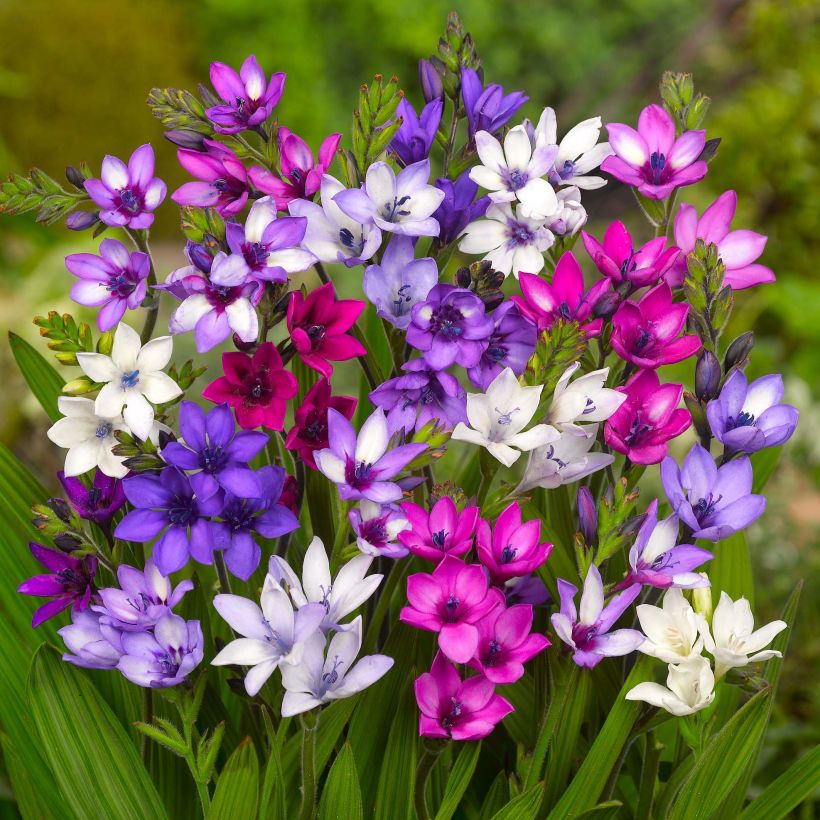

Plant habit
Flowering
Foliage
Botanical data
Babiana
stricta
Iridaceae
Baboon Flower, Blue Freesia
South Africa
Other Gladioli
Planting and care
Plant Babiana in a very well-drained, loamy and sandy soil, light, porous, not retaining water. Install them in the sun in northern regions, but preferably under a light shade in the afternoon in the south. Limestone is well tolerated. In our hot regions, Babiana blooms earlier and goes dormant in summer to escape drought. If water is lacking in spring, the plant will produce leaves but no flowers. It needs water to bloom but likes to spend the summer in fairly dry soil. In colder and wetter regions, it blooms a little later and also goes into dormancy a little later.
Bury the corms with long 'necks' 15cm (6in) deep, spaced 20cm (8in) apart (the 'neck' should be flush with the soil surface). Water regularly to prevent the substrate from drying out. In our regions with pronounced winters (temperatures below -7°C (19.4°F)), dig up the corms in autumn and bring them indoors away from the cold, as you do with large hybrid gladioli. Alternatively, grow them in pots, which you will bring indoors in winter to a slightly heated but very bright room, without overwatering. In milder climates, the corms can stay in the ground all winter.
In heavy soil, mix your garden soil with a little compost, a lot of coarse sand, and a pinch of special bulb fertilizer.
After flowering, cut the faded stem, but be careful to keep the leaves on the plant to allow it to regenerate and multiply.
Planting period
Intended location
Care
-
, onOrder confirmed
Reply from on Promesse de fleurs
Bulbs to grow in pots
Haven't found what you were looking for?
Hardiness is the lowest winter temperature a plant can endure without suffering serious damage or even dying. However, hardiness is affected by location (a sheltered area, such as a patio), protection (winter cover) and soil type (hardiness is improved by well-drained soil).

Photo Sharing Terms & Conditions
In order to encourage gardeners to interact and share their experiences, Promesse de fleurs offers various media enabling content to be uploaded onto its Site - in particular via the ‘Photo sharing’ module.
The User agrees to refrain from:
- Posting any content that is illegal, prejudicial, insulting, racist, inciteful to hatred, revisionist, contrary to public decency, that infringes on privacy or on the privacy rights of third parties, in particular the publicity rights of persons and goods, intellectual property rights, or the right to privacy.
- Submitting content on behalf of a third party;
- Impersonate the identity of a third party and/or publish any personal information about a third party;
In general, the User undertakes to refrain from any unethical behaviour.
All Content (in particular text, comments, files, images, photos, videos, creative works, etc.), which may be subject to property or intellectual property rights, image or other private rights, shall remain the property of the User, subject to the limited rights granted by the terms of the licence granted by Promesse de fleurs as stated below. Users are at liberty to publish or not to publish such Content on the Site, notably via the ‘Photo Sharing’ facility, and accept that this Content shall be made public and freely accessible, notably on the Internet.
Users further acknowledge, undertake to have ,and guarantee that they hold all necessary rights and permissions to publish such material on the Site, in particular with regard to the legislation in force pertaining to any privacy, property, intellectual property, image, or contractual rights, or rights of any other nature. By publishing such Content on the Site, Users acknowledge accepting full liability as publishers of the Content within the meaning of the law, and grant Promesse de fleurs, free of charge, an inclusive, worldwide licence for the said Content for the entire duration of its publication, including all reproduction, representation, up/downloading, displaying, performing, transmission, and storage rights.
Users also grant permission for their name to be linked to the Content and accept that this link may not always be made available.
By engaging in posting material, Users consent to their Content becoming automatically accessible on the Internet, in particular on other sites and/or blogs and/or web pages of the Promesse de fleurs site, including in particular social pages and the Promesse de fleurs catalogue.
Users may secure the removal of entrusted content free of charge by issuing a simple request via our contact form.
The flowering period indicated on our website applies to countries and regions located in USDA zone 8 (France, the United Kingdom, Ireland, the Netherlands, etc.)
It will vary according to where you live:
- In zones 9 to 10 (Italy, Spain, Greece, etc.), flowering will occur about 2 to 4 weeks earlier.
- In zones 6 to 7 (Germany, Poland, Slovenia, and lower mountainous regions), flowering will be delayed by 2 to 3 weeks.
- In zone 5 (Central Europe, Scandinavia), blooming will be delayed by 3 to 5 weeks.
In temperate climates, pruning of spring-flowering shrubs (forsythia, spireas, etc.) should be done just after flowering.
Pruning of summer-flowering shrubs (Indian Lilac, Perovskia, etc.) can be done in winter or spring.
In cold regions as well as with frost-sensitive plants, avoid pruning too early when severe frosts may still occur.
The planting period indicated on our website applies to countries and regions located in USDA zone 8 (France, United Kingdom, Ireland, Netherlands).
It will vary according to where you live:
- In Mediterranean zones (Marseille, Madrid, Milan, etc.), autumn and winter are the best planting periods.
- In continental zones (Strasbourg, Munich, Vienna, etc.), delay planting by 2 to 3 weeks in spring and bring it forward by 2 to 4 weeks in autumn.
- In mountainous regions (the Alps, Pyrenees, Carpathians, etc.), it is best to plant in late spring (May-June) or late summer (August-September).
The harvesting period indicated on our website applies to countries and regions in USDA zone 8 (France, England, Ireland, the Netherlands).
In colder areas (Scandinavia, Poland, Austria...) fruit and vegetable harvests are likely to be delayed by 3-4 weeks.
In warmer areas (Italy, Spain, Greece, etc.), harvesting will probably take place earlier, depending on weather conditions.
The sowing periods indicated on our website apply to countries and regions within USDA Zone 8 (France, UK, Ireland, Netherlands).
In colder areas (Scandinavia, Poland, Austria...), delay any outdoor sowing by 3-4 weeks, or sow under glass.
In warmer climes (Italy, Spain, Greece, etc.), bring outdoor sowing forward by a few weeks.

































